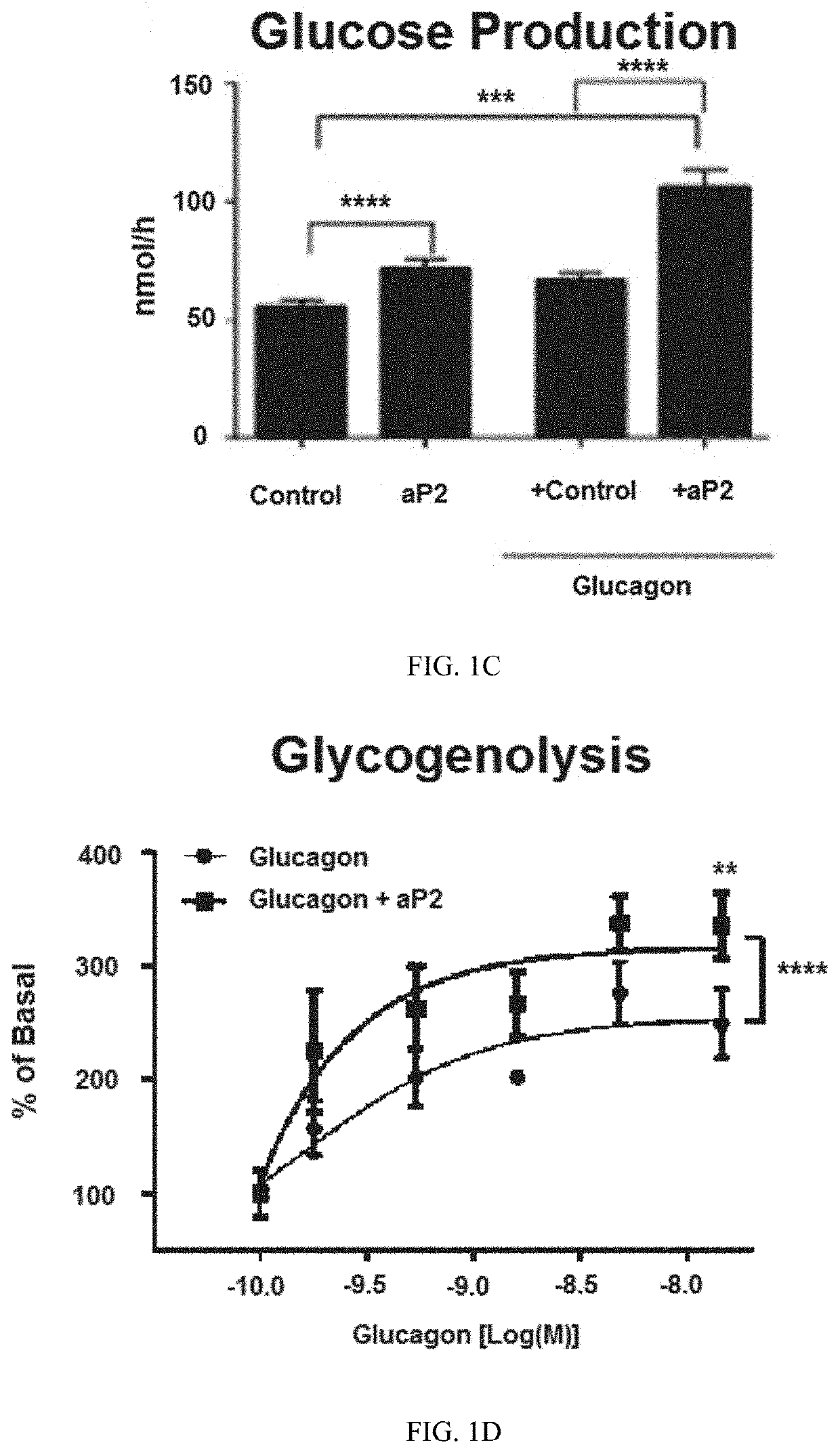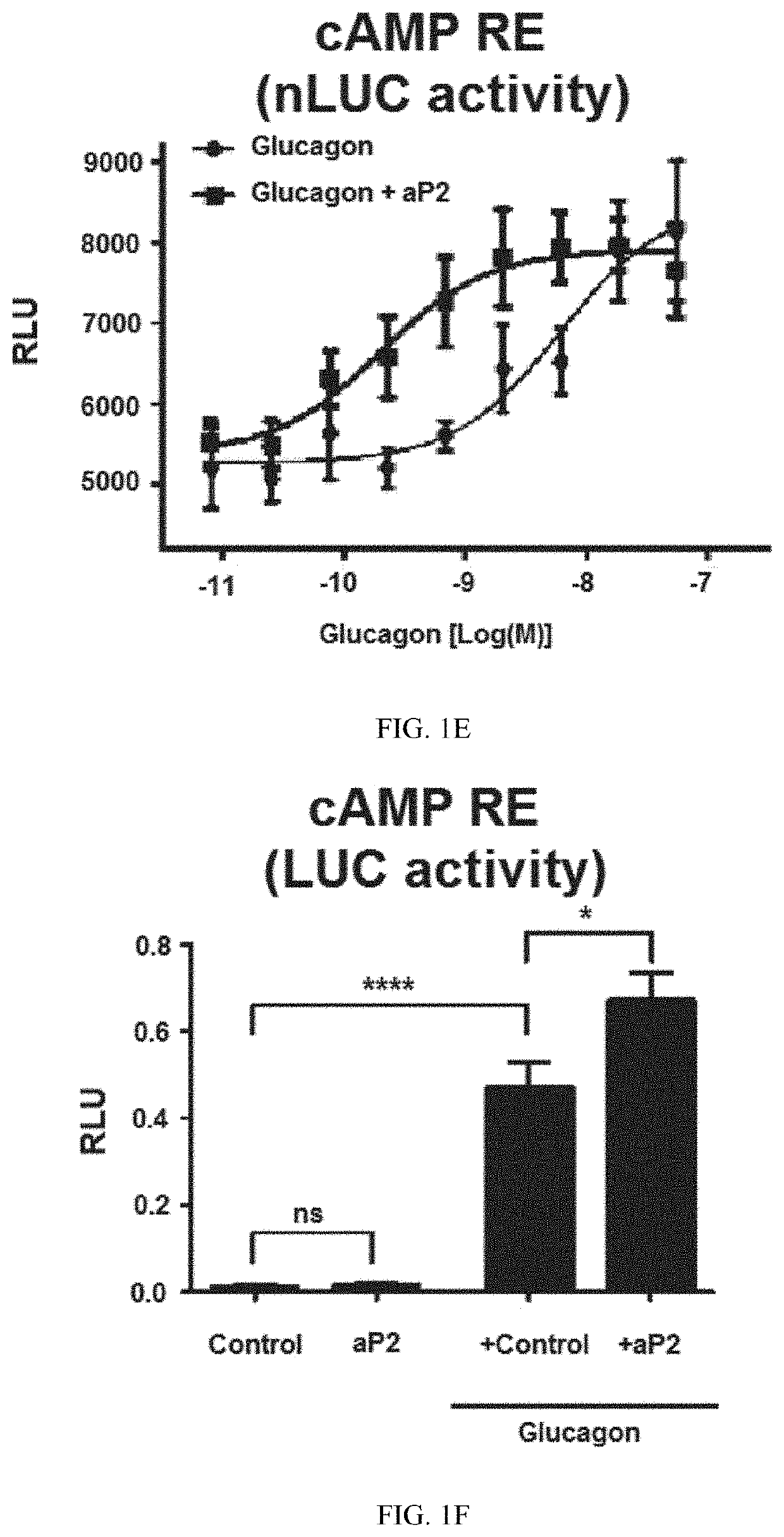Compounds useful to treat metabolic disorders
a metabolic disorder and compound technology, applied in the field of compound useful to treat metabolic disorders, can solve the problems of elevated blood glucose levels, hepatic glucose production, etc., and achieve the effect of reducing or attenuating preventing or attenuating the severity of a disorder, and attenuating the biological activity of glucagon
- Summary
- Abstract
- Description
- Claims
- Application Information
AI Technical Summary
Benefits of technology
Problems solved by technology
Method used
Image
Examples
example 1
ng aP2 Directly Interacts with Glucagon and is Required for Glucagon's Biological Activities
Materials
[0362]All DNA and oligonucleotide synthesis was done by IDT DNA Technologies. L-169,047 (Glucagon Receptor Antagonist II) was purchased from Tocris Biosciences). All other reagents and chemicals were purchased from Sigma-Aldrich and used as received except where otherwise noted.
Bio-Layer Interferometry (BLI) Measurements
[0363]The binding affinity of aP2 to biotin-glucagon was measured by a BLItz Bio-Layer Interferometry system (BLI, Fortébio Inc.) at 25° C. Bio-Layer Interferometry measures the change in the interference pattern of light as ligand in solution binds an immobilized target on a biosensor probe yielding an apparent Kd. Briefly, streptavidin BLItz Dip and Read™—kinetic biosensor probes (Fortébio Inc.) were loaded with 20 μg / mL of biotinylated glucagon in PBS buffer, washed in PBS buffer and baseline readings were taken for 30 seconds in PBS. Association phase readings for...
example 2
on of an Illustrative Monoclonal Antibody Targeting Secreted aP2 / Glucagon / aP2 Protein Complex
[0380]Animals
[0381]Animal care and experimental procedures were performed with approval from animal care committees of Harvard University. Male mice (leptin-deficient (ob / ob) and diet induced obese (DIO) mice with C57BL / 6J background) were purchased from The Jackson Laboratory (Bar Harbor, Me.) and kept on a 12-hour light / dark cycle. DIO mice with C57BL / 6J background were maintained on high-fat diet (60% kcal fat, Research Diets, Inc., D12492i) for 12 to 15 weeks before starting treatment except in clamp studies, for which they were on HFD for 20 weeks. Leptin-deficient (ob / ob) mice were maintained on regular chow diet (RD, PicoLab 5058 Lab Diet). Animals used were 18 to 31 weeks of age for dietary models and 9 to 12 weeks of age for the ob / ob model. In all experiments, at least 7 mice in each group were used, unless otherwise stated in the text. The mice were treated with 150 μl PBS (vehicl...
example 3
ion of CA33
[0404]Rabbit Antibody 909 (CA33) was humanized by grafting the CDRs from the rabbit CDR / mouse framework hybrid antibody V-region CDRs onto human germline antibody V-region frameworks. In order to recover the activity of the antibody, a number of framework residues from the rabbit / mouse hybrid V-region were also retained in the humanized sequence. These residues were selected using the protocol outlined by Adair et al. (1991) (Humanized antibodies. WO91 / 09967). Alignments of the rabbit / mouse hybrid antibody (donor) V-region sequences with the human germline (acceptor) V-region sequences are shown in FIG. 13 (VL) and FIG. 14A (VH), together with the designed humanized sequences. The CDRs grafted from the donor to the acceptor sequence are as defined by Kabat (Kabat et al., 1987), with the exception of CDRH1 where the combined Chothia / Kabat definition is used (see Adair et al., 1991 Humanised antibodies. WO91 / 09967).
[0405]Genes encoding a number of variant heavy and light ch...
PUM
| Property | Measurement | Unit |
|---|---|---|
| dissociation constant | aaaaa | aaaaa |
| temperature | aaaaa | aaaaa |
| pH | aaaaa | aaaaa |
Abstract
Description
Claims
Application Information
 Login to View More
Login to View More - R&D
- Intellectual Property
- Life Sciences
- Materials
- Tech Scout
- Unparalleled Data Quality
- Higher Quality Content
- 60% Fewer Hallucinations
Browse by: Latest US Patents, China's latest patents, Technical Efficacy Thesaurus, Application Domain, Technology Topic, Popular Technical Reports.
© 2025 PatSnap. All rights reserved.Legal|Privacy policy|Modern Slavery Act Transparency Statement|Sitemap|About US| Contact US: help@patsnap.com



